In this final article I try to tie together what I know about the ice-age cycles – and perhaps as relevant, what I do not know.
See also
- Introduction
- Criteria for Cycles
- Global warming and earthquakes
- Thermal crust expansion, decomposition and the Carbon cycle
- Overview of feedbacks
- Climate stability
- Hitting the buffers
- How CO2 could control climate
- Drying of climate
- 5million years of cycles
- Hadley Cells
- The Haseler Gap
- How cycles are triggered + upper threshold
Correlation between overall ice-age cycle and Milankovitch cycle
It has long been known that the occurrence of ice-age cycles is correlated with the temperature 65N. Note this is not the average global insolation (sunshine level), but instead the insolation at a rather odd latitude (i.e. Baltic, sea, Norway, Sweden, Iceland, Canada, Alaska, Greenland).
Also as the graph below shows, not only does the whole cycle match the Milankovitch cycle with the main peak matching peaks in the Milankovitch cycle, but also the smaller speaks on the decline also match.
The model I propose for the overall cycle is this: that the crust expands as we warm into the interglacial leading to active subduction and emissions, then as the temperature cools, the crust begins to cool effectively shutting off (or substantially reducing) the subduction process.
The temperature of the crust then cools/contracts at an exponentially decreasing rate. During this time, various Milankovitch cycles cause small increases
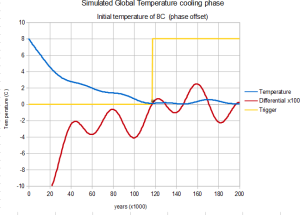 in temperature, but until the rate of crustal cooling is sufficiently low (see right), these are not enough to trigger expansion. However, at some point around 40-120,000 years, the rate of cooling slows sufficiently that the relatively small increase from the Milankovitch cycle is large enough to dominate and when it does, it initiates a small expansion and increase in emissions.
in temperature, but until the rate of crustal cooling is sufficiently low (see right), these are not enough to trigger expansion. However, at some point around 40-120,000 years, the rate of cooling slows sufficiently that the relatively small increase from the Milankovitch cycle is large enough to dominate and when it does, it initiates a small expansion and increase in emissions.This warming then causes further crust expansion and this leads to warming and a runaway warming process.
Change in ice-age cycle length
Therefore, as covered in the last article the change in ice-age cycle length which was previously around 40,000 years is likely because the overall strength of the cycle was less a few million years ago. As such the rate of cooling started at a lower rate and so it was a shorter period before the Milankovitch cycle was stronger enough to trigger another warming phase.
Absence of runaway warming = Strong interglacial negative feedbacks and/or reduction in positive feedbacks
Because the maximum temperature in the interglacials all tend to be very similar (likely the same if we account for noise), this shows that either the positive feedback system catastrophically breaks down at (or indirectly leading to) our current global temperature OR there is a catastrophic negative feedback system that effectively halts further warming (or both).
One possibility is that the crustal expansion is in some way limited. This could be because the crust can only move a certain amount, perhaps a single massive subduction event. However, not only is there no evidence for such an event, and it sounds improbable, but whilst it explains why the catastrophic warming at the beginning of the inter-glacial comes to an abrupt end, it does not explain why all the interglacials have pretty much the same temperature. We need something else to explain this uniformity of interglacial temperature.**
Another possibility, is that the threshold is one whereby we get effectively catastrophic cooling at this level. So, the upper level is like a loaded trigger, which hurls the world into a cooler level and then the world then “bounces back” until it reaches this threshold again which somehow has been reloaded and it triggers another cooling cycle. However, if this were true, we would expect the ice-age cycle to have a sawtooth type form, with a fast drop in temperatures and a slow “bounce back”. But whilst the ice-age temperature cycle is a saw-tooth shape, rather than rapid cooling, there is a fast rise in temperature. In the same way a pinball machine has a fast release followed by a slow drop (as the ball effectively “trickles down the pin-ball machine), so we expect the trigger in the climate to be responsible for the fast rise. So, catastrophic cooling is unlikely.
So, there must be some other form of negative feedback that effectively acts as a “buffer” stopping further increases in temperature in the interglacial.
Of all the phases of the ice-age cycle, the one we must know most about is the current inter-glacial when such buffers must play a role stopping or at least controlling further temperature rise. So, it is strange that almost no such mechanisms have been reported. And indeed, the current literature is filled with suggestions of massive positive feedbacks which are entirely unwarranted given what we know about the ice-age cycle.
Some mechanisms that could increase negative feedback are:
- Increasing atmospheric water vapour “reaches saturation”, leading to a sharp increase in cloud. This must act as a negative feedback so as to counter further warming. (Perhaps only in critical areas such as ~65N?)
- That there is a fundamental change in the climate system such as that suggested from a 3/6 cell Hadley to a 1/2 or perhaps 5/10
- As CO2 increases, the net benefit of increasing CO2 to plants decreases sharply so that the plant-water-vapour feedback effect rapidly falls off above a critical threshold of CO2 thus reducing positive feedbacks and allowing negative feedbacks, that are always present, to start to dominate.
- A.N.Other
However, whilst these all could reduce the rate of warming, none appear to provide the effective “end stop” which appears to exist. Moreover, since the world has been much warmer in the past, such an end stop must in the past have been absent.
Therefore, as discussed in the previous article, having eliminated all other possibilities what remains, becomes the prime candidate. Therefore I suggest the mechanism that effectively halts the catastrophic warming leading into an interglacial is the direct heat absorption of the ice-sheets which effectively stop warming long enough to stabilise the temperature of the crust preventing further expansion, further emissions, and so preventing further warming.
Climate feedbacks
Two things are almost certain with regard to feedbacks:
- That very strong positive feedbacks exist that can be triggered to change the climate from a glacial to an inter-glacial state
- That negative feedbacks come into play at the inter-glacial threshold (either because negative feedbacks increase, or because most positive feedbacks disappear leaving only residual negative feedbacks)
Added to the time scale of 40/100k years, which fits nicely with thermal expansion and contraction of the crust leading to increased/reduced subduction and emissions, it appears that the biggest positive feedback must arise as a direct result of the crustal activity resulting from subduction. Possible candidate are:
- CO2 (direct)
We have direct evidence of rising CO2. However the direct impact of CO2 is very small amounting to perhaps 0.5C of the necessary rise of 8C - CO2 (indirect)
Rising CO2 will increase plant growth leading in turn to increased water vapour. This appears to be one of the best candidates for substantial positive feedback. - Essential element fertilisation (volcanic poisoning)
A theoretical possibility is that subduction and volcanic activity could release vital nutrients that at very low levels might have a significant impact on plant growth. (volcanic activity could release toxic material that decreases plant growth.) - SO2, particles, Other gases
Could affect cloud formation. Perhaps this could lead to cloud types that have a net positive feedback effect? - Direct thermal heat contributed by volcanic activity and rising heated crustal materials
Whilst large in magnitude (sufficient to raise the temperature of the oceans significantly), the size is not sufficient [but should check] to maintain a higher temperature for several tens of thousand years. - Indirect thermal heat contributed by volcanic activity from thermally heated water resulting in “Geyser like” activity (most will just be hot springs).
If, expansion of the crust somehow created fissues that tend to promote masses of water to penetrate deep into the crust and then issue forth as hot springs, this could effectively bypass the insulation of the crust. Theoretically possible, but no evidence whatsoever to support it. - Water Vapour
Whilst volcanic activity would introduce masses of water vapour (stemming from the decomposition of subducted rock), water vapour is quickly lost from the atmosphere. However, volcanic water vapour might “punch through” the tropospheric barrier into the Stratosphere (rather like con trails 🙂 Watts!) - A.N.Other
There’s so much going on in Volcanoes with every element on earth. These could cause any number of unknown influences.
Correlation between Milankovitch Cycles and details of ice-age cycle
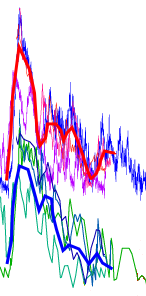
Fig 14.2 Temperature (top). CO2 (bottom) from Vostok ice-core overlaid showing temperature drops after the peak whereas CO2 does not.
Before I started publishing, I wrote a blog post referring to the graph to the right stating that this proves CO2 does not directly cause global temperatures to change. The problem is that whilst the top line (temperature) rises at the same time as the bottom (CO2), temperature then falls around 16,000 years after the inter-glacial peak to a new low, whereas CO2 does not show anything like the same change. So, CO2 is clearly not the direct cause of temperature.
I thought this meant my whole idea was wrong, but as a good climate scientist, I pushed on regardless … or to be more accurate, I decided that some at least of what I had written would still have merit.
However, as a result of a few helpful comments and thinking more about the dip above, I began to realise that it appears to be part of the wider correlation between Milankovitch cycles and climate.
So. e.g. looking at figure 14.1 (blown up as 14.3 to left), we see on the last interglacial some 100k years ago (far right mauve temperature cycle) , there are several pronounced peaks all coinciding with Milankovitch cycles.
Similar detail appear on several other of the cycles, suggesting that the “Haseler Gap” as I euphemistically called it could be caused by a the pronounced cycle of the Milankovitch cycle [Haseler gap – a gap in knowledge!]
In other words, the Milankovitch cycle not only not only triggered the rise in temperature and CO2 when it rose, but it also triggered a drop in temperature when it fell. BUT NOT A COMPARABLE DROP IN CO2.
However, another thing which is also shown in the blown up portion in fig 14.3, is that there is very little activity that can be linked to Milankovitch cycles toward the end of each ice-age period. So, in some way either CO2 or temperature (or both) are affecting the climate’s sensitivity to the Milankovitch cycles so that they diminish in impact as CO2 and temperature reduce.
A model
Having looked at great detail into the ice-age cycle, it is now time to try to model that behaviour using the simplest model. The model I propose consists of the waveforms (and combination thereof) of the following:
- Short term natural variation (white noise)
- A 100k saw-tooth waveform with a sharp rise and slower drop (a more complex model would use an exponential decline)
- A 40k cycle (not used directly)
producing a
40k cycle modulated by the 100k sawtooth (using a non-linear modulation)
The waveform produced by adding together the white noise (top-black), sawtooth (light blue), and modulated 40k (red) is as follows:
And for comparison fig 14.1 again
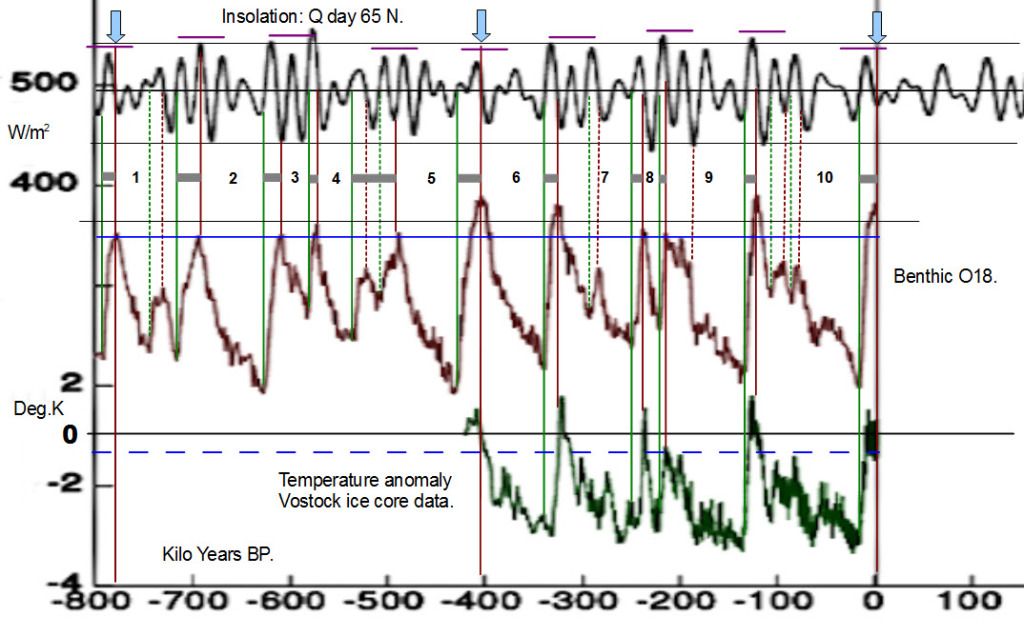 This certainly shares many similar features. It has the overall sawtooth appearance. The smaller peaks on the “back” of the sawtooth tend to be larger when CO2 levels are higher. And we e.g. see similar double peaks appearing.
This certainly shares many similar features. It has the overall sawtooth appearance. The smaller peaks on the “back” of the sawtooth tend to be larger when CO2 levels are higher. And we e.g. see similar double peaks appearing.However, the model is very simple and some features are different. For example, the drop in intensity of variation toward the end of each colder period is greater than the drop in intensity of the model. This could be because the non-linear modulation is wrong, or it could be because climatic variation is reducing (or even that the sensitivity of the record reduces!)
Hypothesis
(deep sigh and gritting of teeth)
It seems clear to me that in some way the climate appears to be “more sensitive” to variation as CO2 and/or temperature increase. This is sharply in contrast (but not necessarily contradictory) to the statement that there is an upper threshold. However, this appears to be what the climate signature says.
I would therefore propose, that the main positive feedback that drives the system is strongly affected by both CO2 levels and temperature.
However as the “Haseler gap” shows, CO2 can remain high in a period when temperatures drop at a time correlated with changes in 65N insolation.
Therefore, there appears to be a relationship of some form whereby:
Temperature change = Insolation (65N) x (global temperature &/or CO2)
I have already suggested in Hadley Cells that temperature at the latitude of the UK could be critical in maintaining the 3/6 Hadley cell structure that we currently see. However, whilst I wrote the article, I am still not entirely convinced that the 1/2 Hadley cell is physically possible (due to Coriolis forces). But, perhaps heating at the latitude of the UK and feedbacks from ocean currents make the strength of the 3/6 Hadley cell very sensitive to temperatures and therefore insolation and other (land-based) climatic effects such as atmospheric moisture at the same latitude.
Northern plant growth
Insolation (aka sunshine), temperature, CO2 and water vapour are all very strong influences on plant growth. With very little ocean around the world at the critical latitude of the UK where 3/6 Hadley cells need warmth/watervapour in order to create to provide the lift to keep the 3/6 cycle going, temperature and plant-derived water vapour may have a very strong influence on climate through modulating the 3/6 Hadley cell and pushing it toward a 1/2 Hadley cell.
In contrast, during inter-glacials, the colder climate, lower CO2 and drier climate creates desert like conditions toward the poles as shown by the dust in ice-cores. This suggests that the main determinant of climate through the ice-age cycle may be northern latitude plant growth which is modulated by northern Insolation (aka sunshine), temperature, CO2 and water vapour. This plant growth in turn affects CO2, water vapour which both have a direct cooling/warming impact on climate, but also directly affect the strength of the prevalent Hadley cell form and thus indirectly modulate climate.
The inter-glacial theshold
It is further proposed that the main causes of the necessary change to negative feedback in the interglacial are:
- The non-linear response of plants to increasing CO2 whose sensitivity to increasing levels reduce with rising CO2.
- General non-linear response to atmospheric water vapour and CO2, so that the direct contribution to warming for any increase in gas, decreases in scale as more gas is present
- Saturation of the climate leading to cloud formation with a strong negative feedback.
**One reason for the uniformity of the inter-glacials which I cannot totally dismiss, is that above a certain level, the ice caps melt and effectively wipe out all higher temperatures. However, the Benthic record appears to show independent corroboration. But looking at ice, this could mean that temperatures were very much higher in previous interglacials, but we only have a record of temperatures below a certain threshold. However, whilst the temperatures at the very beginning of the formation of the ice-cap is itself an indication of the temperature above which the ice melts, and whilst this is not dissimilar to the interglacials, and whilst this remains a possibility, the corroboration with Benthic records appears to make this unlikely.
Remaining issues
Areas where I am still do not feel I have fully understand what is going on are:
The lag between temperature and CO2
This is yet further proof that CO2 does not directly cause global temperature. However, CO2 and its interaction with plant growth is a key to this theory. I would propose that perhaps direct release of water vapour by volcanic emissions in the drier glacial climate and/or other emissions initially lead to temperature rise with the plant-based cycle lagging.
Earthquake depth
I would have preferred to see substantial expansion and contraction of the crust going deeper than would be suggested by my calculations. That is, into the depths where we see earthquakes. I have not touched on this, because whilst we know the depth of earthquakes in the present interglacial, we cannot know for certain that this isn’t an “echo” of the warming as it penetrates further and further into the crust and that at the warming phase, the majority of earthquakes occurred by higher in the crust.
Coriolis force
When I first looked at the possibility of a different configuration of the Hadley cell, I started reading about the Coriolis force and soon realised that the size of the proposed cell was much larger than would be expected from calculations based on the Coriolis force. But then I found that the present cell structure is also too large.
Clearly angular momentum is being lost from the system by surface interaction of the winds. Also, the Coriolis force would work if the wind speed were altered. These could be fundamental barriers, but they may not.
However, I am convinced that the 3/6 Hadley cell structure will be sensitive to changes around the latitude of Britain which fits well with the Milankovitch cycle which appears to have most influence around 65N.
Ice sheet mountains
I may write a further article on this, but it is fairly obvious to me, that if ice-sheets form that are a mile high, they will directly influence the climate. Indeed, it is possible that these ice-sheets represent a coming together of cold and warm air, so that we effectively get ring ridge formed around the world effectively cutting off the polar region.
At the time I was thinking of this, I was considering a massive change from the 5/10 Hadley Cell to the 1/2 in the ice-age. As such I could see that these ice-mountains would effectively create a barrier to wind coming from the pole to the equator.

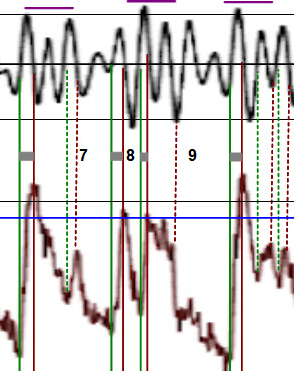
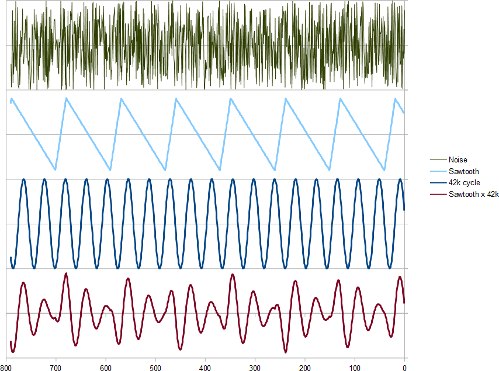


“Rising CO2 will increase plant growth leading in turn to increased water vapour. This appears to be one of the best candidates for substantial positive feedback.”
More water vapor means the water cycle will ramp up and help move warm moist air to altitude, carrying energy away from the surface. The water cycle is a huge, global heat engine that would ramp up with slight warming. There is no positive feedback from water vapor in the presence of the water cycle.
Also, the conclusion that CO2 can warm the atmosphere in any way is weak, as water vapor and CO2 in the atmosphere also act as radiating gases to convert atmospheric heat energy to IR which is lost to space. The models have no night time and these gases work all night unopposed by insolation. More CO2 means a cooler planet.
In addition, the assumption that the surface temperatures can alter the core temperature of the crust is a bit of a stretch. You have the crust as being much too responsive over time to changes on the surface. The planet does heat the crust from below as well. That part appear a bit weak.
Good point: “There is no positive feedback from water vapor in the presence of the water cycle”
Perhaps I didn’t make it clear enough in the summary that this is water vapour into a dry climate. There’s more in the earlier articles
How CO2 could control climate
Drying of climate
But in summery, this is water vapour being added to a climate which is largely devoid of the “presence of the water cycle” as you put it.
However, the article hitting the buffers discusses what brings the warming phase to an end of which a prime candidate is that we see the establishment of the “presence of the water cycle”.
I’d be interested to know if you agree with this – at least as theoretical possibility.
On the direct CO2 warming – the effect is so small that I’ve largely ignored it for this analysis. But by promoting plant growth it can increase evaporation over the land, reduce plant transpiration (it takes less stomata, so less surface area where water can be lost to obtain the same CO2 for cell growth).
“In addition, the assumption that the surface temperatures can alter the core temperature of the crust is a bit of a stretch.”
The equations are in this section: http://scottishsceptic.co.uk/2015/02/05/toward-a-new-theory-of-ice-ages-iii-global-warming-and-earthquakes/
What is more important is whether a few kilometers at the surface is enough to expand the whole crust. The important thing here is that rock is stronger under compression than elongation, so that a wedge at one side can break apart a whole slab.
Very good series with much food for thought.
Areas that I do not remember you touching on are the following:
1. What causes the ice ages (times when there are permanent large areas of ice on the earth; such as the poles, or Greenland) to occur in the first place? Per the records I’ve seen, there have been 4 ice ages (with one being where the entire planet was covered with ice). But, most of the time, by far, the earth has not been in an ice age at all. If I remember correctly, the ice ages increased/arrived only after the earth had aged a certain amount, but each ice age was separated by hundreds of millions of years from each prior ice age.
2. Similar to above, why would an “ice age” stop?
Can’t remember if some of the possible reasons were internal (volcanoes) or external (asteroid, gamma ray, sun phases, etc.).
Thanks,
Geoff Weatherford
very good question! The reason I focus on the ice-age cycle over the last 2million years is because we have more evidence than over longer periods. There is no evidence I can see of a repeated theme, each ice-age seems to be associated with very different conditions and different time intervals and durations. Therefore if there is a single “cause” it is hidden. Instead I would suggest that each ice age** period is “caused” by a unique set of factors to that ice-age period.
**ice-age was coined to refer to periods of glaciation at our European latitudes and it is used in that way in many subjects.